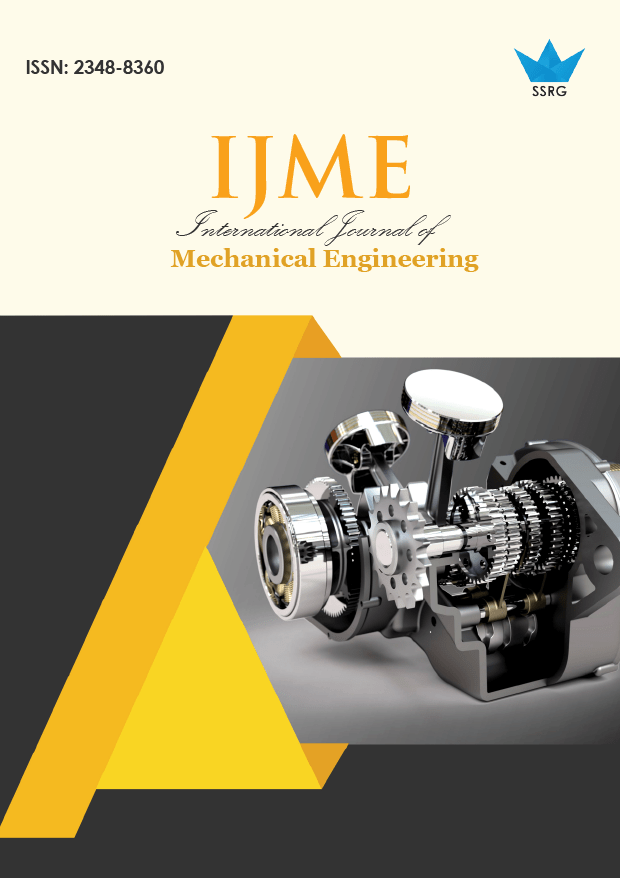Finite Element Analysis of Vibration Damping in Two-Wheeler Seats: Effects of Foam Density, Thickness, and Multilayer Configurations

| International Journal of Mechanical Engineering |
| © 2025 by SSRG - IJME Journal |
| Volume 12 Issue 7 |
| Year of Publication : 2025 |
| Authors : Vishwanath Mali, Ajit Bhosale |
How to Cite?
Vishwanath Mali, Ajit Bhosale, "Finite Element Analysis of Vibration Damping in Two-Wheeler Seats: Effects of Foam Density, Thickness, and Multilayer Configurations," SSRG International Journal of Mechanical Engineering, vol. 12, no. 7, pp. 18-24, 2025. Crossref, https://doi.org/10.14445/23488360/IJME-V12I7P103
Abstract:
The ride comfort of two-wheeler vehicles is significantly influenced by the design of the seat, particularly the seat foam thickness, density and structural configuration. Prolonged exposure to whole-body vibration (WBV) in two-wheelers leads to rider discomfort and musculoskeletal injuries. This study presents a simulation-based investigation using Finite Element Analysis (FEA) in ANSYS Workbench to assess the vibration-damping performance. The hyperelastic polyurethane foams, modelled using the Ogden formulation, were simulated under harmonic base excitation in the 1–50 Hz frequency range aligned with ISO 2631 standards corresponding to the human whole-body vibration sensitivity spectrum. Ten load cases were analysed, including variations in foam density (50–70 kg/m³), thickness (35–45 mm), and novel multilayer configurations. Results revealed that increasing density from 50 to 70 kg/m³ reduced transmissibility by over 60%, while increasing thickness from 35 mm to 45 mm nearly halved it. Multilayer structures with high-density base layers (70+60 kg/m³) lowered transmissibility to 0.44, outperforming single-layer foams by 13–18% through synergistic compliance-damping effects. This study establishes that optimised combinations of density, thickness, and multilayer design significantly enhance two-wheeler seat performance in terms of ride comfort and vibration damping.
Keywords:
Vibration damping, Finite Element Analysis, Polyurethane foam, Transmissibility, Multilayer seat design.
References:
[1] Marton Tomin et al., “Measuring and Mathematical Modelling of Cushion Curves for Polymeric Foams,” Polymer Testing, vol. 117, pp. 1-9, 2023.
[CrossRef] [Google Scholar] [Publisher Link]
[2] Mohammad Adnan Farooq, and Sanjay Nimbalkar, “Static and Cyclic Performance of Polyurethane Foam Adhesive-bound Soil–rubber Mixtures Under Drained Conditions,” Acta Geotechnica, vol. 19, pp. 561-589, 2024.
[CrossRef] [Google Scholar] [Publisher Link]
[3] Pavel Srb, and Michal Petru, “Numerical Simulation of Composite Car Seat Cushion,” MM Science Journal, pp. 1-6, 2020.
[CrossRef] [Google Scholar] [Publisher Link]
[4] Chih-Jen Chang et al., “Reinforcing a Thermoplastic Starch/Poly (Butylene Adipate-co-terephthalate) Composite Foam with Polyethene Glycol under Supercritical Carbon Dioxide,” Polymer, vol. 15, no. 1, pp. 1-14, 2023.
[CrossRef] [Google Scholar] [Publisher Link]
[5] Georges Abinader et al., “Effect of the Formulation of Starch-based Foam Cushions on the Morphology and Mechanical Properties,” Journal of Cellular Plastics, vol. 51, no. 1, pp. 31-44, 2014.
[CrossRef] [Google Scholar] [Publisher Link]
[6] Xiaolu Zhang, Yi Qiu, and Michael J. Griffin, “Transmission of Fore-and-aft Vibration to the Seat Pan, The Backrest and The Headrest of a Car Seat,” Proceedings of the Institution of Mechanical Engineers, Part D: Journal of Automobile Engineering, vol. 230, no. 6, pp. 736-744, 2015.
[CrossRef] [Google Scholar] [Publisher Link]
[7] Elena Zharinova et al., “Water-blown Polyurethane Foams Showing a Reversible Shape-memory Effect,” Polymers (Basel), vol. 8, no. 12, 2016.
[CrossRef] [Google Scholar] [Publisher Link]
[8] Pu Gao et al., “Vibration Reduction Performance of an Innovative Vehicle Seat with a Vibration Absorber and Variable Damping Cushion,” Proceedings of the Institution of Mechanical Engineers, Part D: Journal of Automobile Engineering, vol. 236, no. 4, pp. 689-708, 2021.
[CrossRef] [Google Scholar] [Publisher Link]
[9] Amin Joodaky, Gregory S. Batt, and James M. Gibert, “Prediction of Cushion Curves of Polymer Foams using a Nonlinear Distributed Parameter Model,” Packaging Technology and Science, vol. 33, no. 1, pp. 3-14, 2020.
[CrossRef] [Google Scholar] [Publisher Link]
[10] Paulina Parcheta-Szwindowska et al., “Fabrication and Characterization of Green Polyurethane Foams with Enhanced Vibration-Damping Capability,” ACS Sustainable Chemistry & Engineering, vol. 11, no. 39, pp. 14348-14357, 2023.
[CrossRef] [Google Scholar] [Publisher Link]
[11] Xiaolu Zhang, Yi Qiu, and Michael J. Griffin, “Transmission of Vertical Vibration Through a Seat: Effect of Thickness of Foam Cushions at the Seat Pan and The Backrest,” International Journal of Industrial Ergonomics, vol. 48, pp. 36-45, 2015.
[CrossRef] [Google Scholar] [Publisher Link]
[12] Peter Csavajda, and Peter Böröcz, “Experimental Study on Vibration Transmissibility of Pre-loaded XPE and PE Packaging Cushioning Material,” FME Transactions, vol. 49, pp. 962-968, 2021.
[CrossRef] [Google Scholar] [Publisher Link]
[13] Eunyeong Kim, Mohammad Fard, and Kazuhito Kato, “A Seated Human Model for Predicting the Coupled Human-Seat Transmissibility Exposed to Fore-aft Whole-body Vibration,” Applied Ergonomics, vol. 84, 2020.
[CrossRef] [Google Scholar] [Publisher Link]
[14] Chi Liu, and Yi Qiu, “Localised Apparent Masses Over the Interface Between a Seated Human Body and A Soft Seat During Vertical Whole-body Vibration,” Journal of Biomechanics, vol. 109, 2020.
[CrossRef] [Google Scholar] [Publisher Link]
[15] Yanfeng Guo, and Jinghui Zhang, “Shock Absorbing Characteristics and Vibration Transmissibility of Honeycomb Paperboard,” Shock and Vibration, 2003.
[CrossRef] [Google Scholar] [Publisher Link]
[16] Junho Moon et al., “Synthesis of Polyurethane Foam from Ultrasonically Decrosslinked Automotive Seat Cushions,” Waste Management, vol. 85, pp. 557-562, 2019.
[CrossRef] [Google Scholar] [Publisher Link]

 10.14445/23488360/IJME-V12I7P103
10.14445/23488360/IJME-V12I7P103